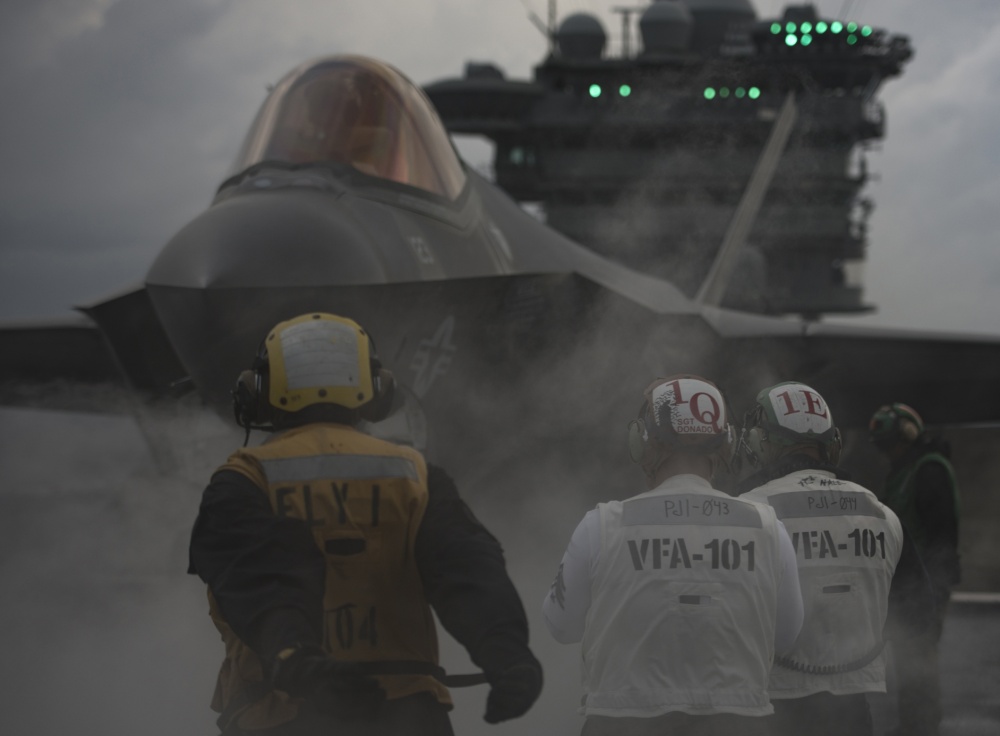An F-35C Lightning II assigned to Strike Fighter Squadron (VFA) 101 is positioned on the bow catapults of the Nimitz-Class aircraft carrier USS Abraham Lincoln (CVN-72) March 17, 2018, in the Atlantic Ocean. US Navy photo
It’s looking less and less likely the carrier-variants of the F-35 Lightning II Joint Strike Fighter will be ready for combat this year as has long been planned, but their first deployment is still expected in 2021.
For years, the Pentagon targeted initial operational capability (IOC) for the F-35C – the version designed to land on and take off from aircraft carriers – between August 2018 and February 2019, according to a June 2013 report to Congress.
This timeline was mentioned as recently as September 2017, when the Navy issued a release detailing F-35Cs testing takeoff and landing aboard USS Abraham Lincoln (CVN-72). According to the Navy release, “according to the F-35 Lightning II Pax River Integrated Test Force, the F-35C should reach its initial operational capability in 2018.”
Now signs indicate the 2018 date could be slipping to the right because of when the F-35 program can test the upgraded 3F software package in a formal Initial Operations Test and Evaluation (IOT&E). This is an F-35 enterprise testing event, not just an evaluation of the Navy’s F-35s, Rear Adm. Dale Horan told USNI News. Horan is the Navy’s director of Joint Strike Fighter Fleet Integration. Block 3F provides 100 percent of the software required for full warfighting capability, including data link imagery, full weapons, and embedded training, according to F-35 contractor Lockheed Martin.
“The whole F-35 enterprise’s IOT&E starts in September, so it’s not Navy F-35C that’s holding up IOC, it’s that we’re tied to IOT&E and need to see the demonstration and capabilities. We need to really see the 3F capability demonstrated in IOT&E and there’s just not going to be enough time to see enough of that before Feb. 2019,” Horan said.
“It’s DoD’s opportunity to test drive their new airplane.”
Similarly, the 2013 report to Congress notes the timeline would be event-driven rather than calendar-driven, leaving some wiggle room for the 2018 to 2019 IOC time range, stating, “should capability delivery experience changes or delays, this estimate will be revised appropriately.”
The upcoming IOT&E round of software testing is designed to show the military how well the 3F package works in mission situations and is an integral part of declaring the F-35C combat ready, wrote Rear Adm. Scott Conn in testimony provided on March 7 to the House Armed Services tactical air and land forces subcommittee.
“After eleven years and over 16,000 flight hours, the full Block 3F SDD (system development and demonstration) developmental test phase is quickly approaching an end,” Conn wrote.
“We estimate completion to be March/April 2018. The program can now proceed into IOT&E (initial operational test and evaluation). IOT&E is critical to the Navy because we have linked the successful demonstration of 3F capabilities in IOT&E to our IOC declaration for the F-35C. Our IOC criteria states that the aircraft will be in a 3F configuration with the ability to conduct assigned operational missions utilizing SDD program of record weapons, mission systems, sensors and performance envelopes. … IOC is capability and event driven, not calendar driven. The Navy understands that the threshold and objective dates, August 2018 and February 2019, are at risk due to a delay in the IOT&E schedule. Once full 3F capability has been demonstrated in IOT&E, and all other IOC criteria have been met, the Navy will declare that the F-35C has achieved Initial Operational Capability.”
IOT&E will start after the long-predicted IOC, but Horan said there’s a possibility the Navy can see what it needs fairly quickly and still declare the F-35C combat ready inside the expected window.
“I’m just saying that’s those dates are at risk and it’s based on the capabilities and events that we need to see,” Horan said.
Interestingly, while not saying a delayed IOC is certain, both Navy and Lockheed Martin statements suggest this is case because of what is not said.
A year ago, Lockheed Martin’s annual report provided investors with an F-35 update. “The program continues to advance towards the U.S. Navy declaring the F-35C carrier variant ready for combat in 2018, as demonstrated by completing final carrier tests aboard the USS George Washington in 2016,” the report states.
Fast-forward a year, and the current Lockheed Martin annual report, released on Feb. 6, does not mention when the F-35C will be combat-ready. The company update to investors only states, “we continue to advance towards the U.S. Navy declaring the F‑35C carrier variant ready for combat.”
Since then, Navy mention of F-35C IOC has seemingly disappeared. Last week, when pilots conducted F-35C day and night qualifications aboard Abraham Lincoln, there was no mention of a 2018 IOC. A Navy release described this significant milestone as being “in anticipation of F-35C operational testing later this year,” without mentioning an IOC date specifically.
The Navy plans for its carrier air wings by 2025 to include F-35Cs, F/A-18E/F Super Hornets, EA-18G Growler electronic attack aircraft, E-2D Hawkeye battle management and control aircraft, and MH-60R/S helicopters. The first F-35C squadron deploying aboard USS Carl Vinson (CV-70) in 2021. Horan, speaking to USNI News, stressed this, saying as of now, a delayed IOC will not delay the 2021 deployment.
“I don’t see any significant barriers to first deployment,” Horan said.
“We have plenty of work to do. Getting a new aircraft into the fleet will always be a complex issue.”

